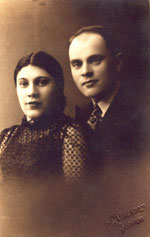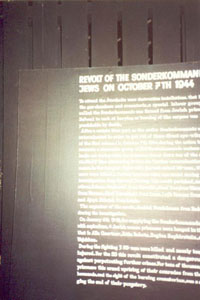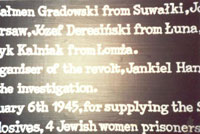| |
The Journey to Auschwitz
On the night of December 5, 1942, the third night of Chanukah, the Jews
of Lunna- Wola and other neighboring towns were ordered to assemble at
the center of Kelbasin Camp (see note 1). Before assembling,
Sarah Gradowski (previously Zlotoyabko) from
Lunna, who was in her thirties, led the Jews of Lunna in singing the
Chanukah hymn "Maoz Tzur" inside the underground hut of the Lunna
Jews. The Jews were forced to walk on a bitterly cold rainy night two
kilometers to the Lososna train station. There they were brutally
shoved into some twenty small railroad wagons. Each car - mostly
freight wagons, although there were a few passenger cars – contained
approximately 120 persons. A single pail was used as a toilet for an
entire car. Very little fresh air could come into these sealed wagons,
and what little did, was bitterly cold. Families tried their best to
stay together. The transport consisted of about 2,500 people, which
included some Jews from towns other than Lunna.
The train made several stops on the way, but the Jews were not allowed
to leave the wagons and the gentiles from the villages through which
the train passed were prohibited by the Germans from giving the Jews
water. During the three-day journey from Kelbasin to Auschwitz, most Jews
ran out of the small amount of water and food that they carried with
them from Kelbasin, and many children and elderly people suffered from
hunger and dehydration. Many Jews on the transport suspected that a
terrible fate awaited them, but they did not know for sure what plans
the Germans had for them.
Zalman Gradowski who was on that transport with his wife Sara and her
family, wrote a detailed account of the journey from Kelbasin to
Auschwitz, which was discovered buried near the crematoria in
Auschwitz after the liberation of the camp in 1945. His journals were
written in Yiddish, translated into Hebrew and were published in "Megilat
Auschwitz" by Ber Mark. Gradowski noted that at one point in the
journey, the train passed Bialystok and the Malkinia Junction, but did
not turn off in the direction of Treblinka. In passing by this
junction, the people in the transport felt relief, and some began to
believe that they were actually being sent to a labor camp. These
unfortunate Jews had heard rumors about an extermination camp in
Treblinka, but did not know about Auschwitz, which was located far
away in the southwestern part of pre-war Poland.
Auschwitz Death Camp
The transport of Jews from Lunna-Wola and the neighboring towns
arrived at Auschwitz between 7 and 9 o’clock on the morning of
December 8, 1942, the fifth day of Chanukah. Out of the entire transport
of 2,500, approximately 315 men were "selected" for labor and joined
the prisoners of Block 9 in the Auschwitz-Birkenau Camp. Of these,
approximately 120 were from Lunna (see note 2).
The rest were sent immediately to the gas chambers, including all
women and children (see note 3). The office responsible
for organizing these transports was known by the official German
acronym "RSHA” (Reichssicherheitshauptamt, or Reich Security
Headquarters). The RSHA was where Adolf Eichmann, among others,
planned and oversaw their murderous activities. According to Danuta
Czech, a historian at the Auschwitz Museum, RSHA Transport No. 3 is
listed at Auschwitz as follows: "December 8, 1942. Jews from
Grodno; 231 men with numbers 80764-80994 were sent into the camp.
Children, mothers, and old men were gassed." To date, we have been
unable to obtain a copy of this transport list, which may contain the
names of the victims.
On the late evening of December 9, 1942, the SS soldiers "selected"
about eighty young, strong men from Block 9. Those persons were moved to
Block 2, which was the block for the Sonderkommandos ("Special
Commandos"), who were forced to carry dead bodies from the gas
chambers on wheelbarrows and burn them in "Bunkers". The Germans
"liquidated" Sonderkommandos every so often and replaced them with
newcomers. The typical Sonderkommando lasted about three months.
A partial list of Sonderkommandos indicates that proportionately
more Jews from the Lunna-Wola transport that arrived on December 8,
1942 were forced to work as Sonderkommandos than from almost any other
town in Europe. We know of at least seventeen persons from Lunna-Wola who
were forced into such work: Zalman Gradowski, Yosef Derewianski, David
Goland, Moshe Chernyawski, Shneur-Zalman Friedman, Eliezer Welbel,
Eliezer Eisenshmidt, Berl Becker, Nissel Lewin, Aizik Nowik, Aron
Leibowicz, Tewel Gisser, Abel (Aba) Suchowlanski, Zalman Rochkin,
his brother Chaim Rochkin, Heshl (Yehoshua) Furman, and his cousin
Kalman Furman (Heshl Furman and Chaim Rochkin died shortly after their
selection).
During the winter of 1942-1943, many of the other persons selected on
December 8, 1942 (but not sent to work as members of the
Sonderkommandos) died from typhus, “pneumonia” (“Lungenentzuendung”)
and other diseases. Motel Gisser, one of the people from Lunna who
arrived in Auschwitz on December 8, 1942 in the RSHA transport from
Kelbasin (Grodno), was assigned the camp number: 80828.
|
In the book of the camp infirmary -
block 28 - Motel Gisser is noted as having been admitted to Auschwitz 1,
Block no. 28, on January 1, 1943 from Auschwitz III – Monowitz
(Buna); then on January 2, he was transferred to block 20. On
January 3, 1943 his death was registered at the camp. It is
known that many prisoners sent to Block 20 were murdered by
phenol injection ("Abspritzen"), even though their
German-prepared death certificates list various natural
causes. Notwithstanding Motel’s death certificate, his exact
cause of death therefore remains unknown. |

|
| |
Auschwitz Death Record of Motel Gisser |
|
By the end of 1943 - approximately one year after the transport of
Jews from Lunna and the neighboring towns arrived at Auschwitz – only
about thirty people remained alive from the several hundred persons who
survived the initial selection. As noted, most of those thirty persons
were forced to "work" in the crematoria and gas chambers in Birkenau
as members of the Sonderkommandos, while other more "fortunate" Lunna
Jews including Moni Berenhaus were forced to work in the "Canada Unit" (sorting out clothing
and other personal possessions of the countless victims). A few Jews
were forced to work as sewer workers, digging holes and building
canals, as well as performing other work duties in the main Auschwitz
camp or its satellite camps.
By the spring of 1944, the Germans were operating four crematoria in
Birkenau, which they numbered II, III, IV, V (the prisoners used the
numbers: I, II, III and IV; further references will use the German
numbering system.) The crematoria also included undressing rooms and
gas chambers; two were underground (Crematory II and III) and two were
at ground level (Crematory IV and V). Approximately one-hundred-twenty
Sonderkommandos worked at each crematorium. The Sonderkommandos from
Lunna who were forced to work in Crematory II were: Zalman Gradowski,
Yosef Derewianski, David Goland, Moshe Chernyawski, and Shneur-Zalman
Friedman. Those in Crematory IV were: Eliezer Welbel, Eliezer
Eisenshmidt, Berl Becker, Nissel Lewin, Aizik Nowik, Aron Leibowicz,
Tewel Gisser, Aba Suchowlanski (Nissel Lewin's brother-in-law), Zalman
Rochkin, and Kalman Furman.
By the late spring of 1944, even as it was evident to the world that
Germany was going to lose the war, the German murder machine ramped up
to its greatest tempo. Within just a few months, the Germans murdered
almost two-thirds of the 825,000 Jews of Hungary. By October 7, 1944,
after the vast majority of European Jewry had been murdered,
including, most recently, the majority of the Jews of Hungary and the
last remaining Jewish Ghetto in Poland, Lodz, the SS, on Himmler’s
orders, slowly began to wind down operations at Auschwitz. This
decision was based, in part, on the fact that the transports had
dwindled to a small percentage of what they had been, and due to the
rapidly approaching Russian Army.
Over the course of 1944, the Sonderkommandos had heard from various
sources that the SS soldiers were planning to liquidate all of them.
As early as the Spring of 1944, Sonderkommando members, including
those from Lunna, made preparations to revolt. They prepared makeshift
weapons including stones, axes, as well as homemade grenades from
explosives that were smuggled from a munitions factory by female
inmates on the outside. The Polish resistance from outside the camp
and a few Russians inside the camp were also involved in planning the
revolt. For various reasons, however, the Polish partisans, who were
deemed necessary to the success of the revolt, postponed the plan.
On October 7, 1944, in the morning, the Germans ordered the
Sonderkommando members into a formation ("Appel") and selected thirty
members, including the group of people from Lunna who had "worked" in
Crematory IV and isolated them in Crematory V (see
note 4).
A few hours later, some other Jewish members of the
Sonderkommando in Crematory IV set the crematory on fire, destroying
the gas chambers and the crematory. The Sonderkommando members taking
part in the uprising also planned to blow up Crematory II and managed
to kill three of the Germans and wounded about twelve others. During the
actual revolt, 451 Sondekommando members were killed by the Germans
and 212 remained alive (see note 5).
The Lunna residents
who were killed during the Sonderkommando uprising were: Zalman
Gradowski and Yosef Derewianski, who were among the leaders of the
revolt, David Goland, Moshe Chernyawski and Shneur-Zalman Friedman.
Some of the persons who were not shot during the rebellion were in
fact murdered in the next few days. According to Mr. Eisenshmidt, in
the remaining three months before the Auschwitz camp was "evacuated"
(in January 1945), approximately seventy-five Sonderkommando members (out of the
212 who remained alive after the revolt) were either killed by the
Germans or died. Those thirty members who were isolated in Crematory V
(including the group of people from Lunna) were forced to burn the
bodies of those inmates who died in Auschwitz and the neighboring
camps, while other Sonderkommando members who remained alive were
forced to work in disassembling and destroying Crematory II and III
(see note 6).
It should be noted that, despite the fact that, as mentioned above,
the average life expectancy of a worker in the Sonderkommando was
approximately three months, most of the Lunna Jews survived almost two
years or longer working in the crematoria (except for two persons who
were liquidated soon after the selection). The testimony of Eliezer
Eisenshmidt from Lunna, as well as other Jews who were forced to work
in the Sonderkommando, is presented in the book "We Wept without
Tears" by Gideon Greif.
By the beginning of 1945, the Soviets were rapidly approaching
Auschwitz. In the face of certain defeat, the Germans destroyed
records, blew up the existing crematoria and gas chambers, and
forcibly evacuated those prisoners capable of walking, all with the
intent of covering up all traces of their crimes. Tens of thousands of
prisoners, mostly Jews, were forced to march in bitter cold conditions
with little clothing on their backs, in the general direction of
Germany. All of the Jews of Lunna who had managed to remain alive in
Auschwitz were among about 5,000 prisoners who were forced on this
death march from Auschwitz on January 18, 1945. Many of these 5,000
evacuees died, while others eventually arrived in various other camps
in Austria and Germany and were liberated from May 5 to May 9, 1945.
Some 7,000 Jews who were too ill to walk remained in Auschwitz and were
liberated by the Soviets on January 27, 1945. Many of these persons
died shortly after their liberation.
As noted above, Zalman Gradowski recorded the events starting with the
deportation of the Jews from the Lunna-Wola Ghetto to Kelbasin Camp,
through his experiences in the Sonderkommando in Auschwitz. His notes
were found in tin cans under the ruins of the gas chambers after the
war. These notes document the mass killing of Jews in the camp's gas
chambers, as well as the work of the Sonderkommandos. Other members of
the Sonderkommandos (including Zalman Levental and Leib Langfus) also
buried accounts of the murder of European Jewry that were found after
the war (see note 7).
|
 |

|

|
|
|
Zalman Gradowski and his wife Sarah née Zlotoyabko (ca. 1935)
(From the collection of Libe Friedman-Ahuava Glick) |
|
|
Sarah Gradowski dedicated the picture to Libe Friedman-Ahuva Glick |
|
|
Yosef Derewianski (Horodyszcze, 5.7.1934)
(From the collection of Liza Welbel-Shwetz) |
|
|

|

|
|
|
Memorial Monument for the revolt of Sonderkommando in Auschwitz-Birkenau
(photo taken by Eliezer Eisenshmidt, 1993) |
|
|
Names of Zalman Gradowski & Yosef Derewianski on the above monument
(photo taken by Eliezer Eisenshmidt, 1993) |
|
Notes
Note 1: According to Eisenshmidt, the other neighboring towns were:
Ozory and Yanov. However, he is not too certain about it since he was
ill in Kelbasin camp. >back
Note 2: The numbers 315 and 120 are based on Eisenshmidt's estimates.
>back
Note 3: In a sad twist of fate, later that same day, a number of
rabbis and leaders of the American Jewish community met with President
Franklin Delano Roosevelt to urge him to take action against the
genocide of the Jews of Europe.
http://www.jewishvirtuallibrary.org/jsource/Holocaust/fdrmeet.html
>back
Note 4: Zalman Rochkin and Kalman Furman from Lunna were not among
these 30 members since they were killed by the Germans before October 7,
1944. >back
Note 5: See: "We Wept without Tears" by Gideon Greif, p. 78
>back
Note 6: According to Piper's lists, the last transport arrived in
Auschwitz on October 28, 1944. >back
Note 7: See Megilat Auschwitz by Ber Mark and "We Wept without Tears"
by Gideon Greif. >back
This site is hosted at no cost by JewishGen, Inc., the Home of Jewish
Genealogy. If you have been aided in your research by this site and
wish to further our mission of preserving our history for future
generations, your
JewishGen-erosity is greatly appreciated.
|
Compiled by
Ruth Marcus & Aliza Yonovsky Created
May 2007
Updated by rLb, March 2020
Copyright © 2007 Ruth Marcus
All the photos are presented
by courtesy of the families and are not allowed to be reproduced
without their permission. |
|
|